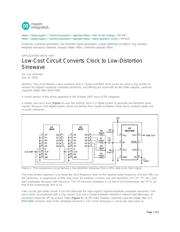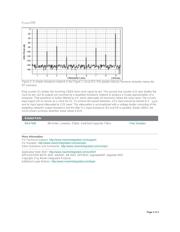下载

Maxim > Design Support > Technical Documents > Application Notes > Filter Circuits (Analog) > APP 4547
Maxim > Design Support > Technical Documents > Application Notes > Signal Generation Circuits > APP 4547
Keywords: sinewave generators, low-distortion signal generators, crystal-stabilized oscillators, ring counters,
weighted-resistance networks, lowpass elliptic filters, switched-capacitor filters
APPLICATION NOTE 4547
Low-Cost Circuit Converts Clock to Low-Distortion
Sinewave
By: Leo Sahlsten
Dec 21, 2010
Abstract: This circuit derives a pure sinewave from a crystal-controlled clock source by using a ring counter to
remove the highest-amplitude unwanted harmonics, and filtering the result with an 8th-order lowpass, switched-
capacitor elliptic filter (MAX7400).
A similar version of this article appeared in the October 2007 issue of PD magazine.
A simple, low-cost circuit (Figure 1) uses the existing clock in a digital system to generate low-distortion audio
signals. Because most digital-system clocks are derived from crystal oscillators, those clocks produce stable and
accurate sinewaves.
Figure 1. This inexpensive circuit derives a low-distortion sinewave from a 50%-duty-cycle clock signal.
The most obvious approach is to divide the clock frequency down to the required audio frequency, and then filter out
the harmonics. A squarewave of 50% duty cycle, for instance, contains only odd harmonics (3
rd
, 5
th
, 7
th
, etc.), and
their amplitudes decrease with frequency. The 3
rd
-harmonic amplitude is 1/3 that of the fundamental, the 5
th
is 1/5
that of the fundamental, and so on.
Filter circuits give better results if you first attenuate the input signal's highest-amplitude unwanted harmonics. This
job is easily accomplished with a ring counter (U2) and a simple weighted-resistance network that attenuates all
harmonics below the 9
th
by at least 70dB (Figure 2). An 8
th
-order lowpass, switched-capacitor elliptic filter (U3,
MAX7400) removes most of the remaining harmonics. U3's corner frequency is set by the input clock as
Page 1 of 2




